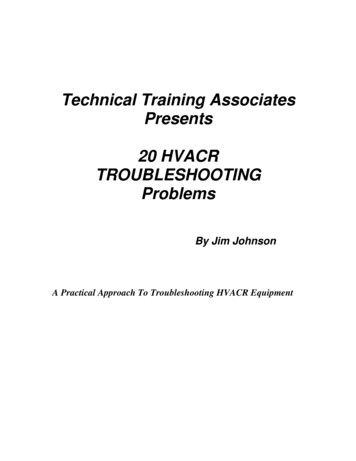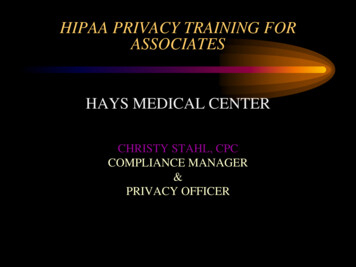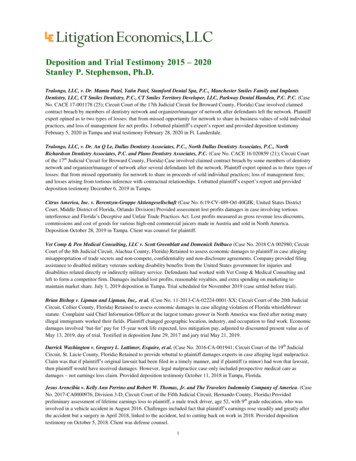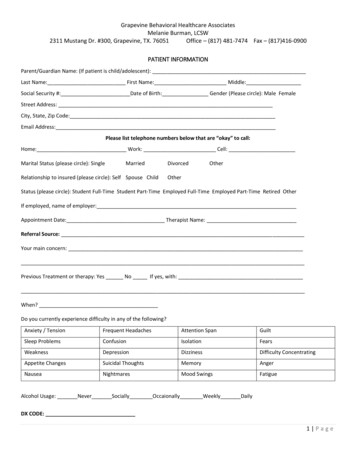
Transcription
Technical Training AssociatesPresents20 HVACRTROUBLESHOOTINGProblemsBy Jim JohnsonA Practical Approach To Troubleshooting HVACR Equipment
20 HVACR Troubleshooting Problems By Jim JohnsonCopyright 2007 Technical Training AssociatesHC 70 Box 3172Sahuarita, AZ 85629(520) 625-6847www.technicaltrainingassoc.comAll digital copyrights reserved. Permission is granted by the publisher to print andphotocopy the material herein for the purpose of conducting individual training sessions.Distribution of hard copy versions to the public for sale, or digital copying of any and allinformation contained herein is prohibited.This troubleshooting handbook contains 20 separate troubleshooting scenarios designedto test the skills of HVACR technicians. In each situation, all the information necessaryto arrive at a diagnosis is provided.The solutions to the problems are presented in a separate section at the end of the book.If you are working individually with this handbook, use it to test yourself. Review theproblem and any related graphics or wiring diagrams, then, record your diagnosis beforechecking your answer in the solutions section.If you are a service manager conducting in-house training sessions, or an instructorfacilitating a classroom or lab training exercise, you may print and photocopy theproblems and diagrams for classroom distribution. Digital copying of this CD isprohibited as noted in the copyright notice above.2
Troubleshooting Problem #1In this situation, you are the follow-up technician on a callback. Theequipment is a standard 3-ton package unit, A/C with gas heat, 208/230, singlephase residential installation.The original complaint was a “no cooling” call and the technician whopreceded you on this job (we’ll call him Technician #1) has only limitedexperience, but he reported correctly that he found a bad transformer andreplaced it.He’s only been gone for an hour-and-a-half, and the customer is callingback to say that the unit is out again and the house is warming up.When you arrive, you find the following conditions:1. An irate, overheated customer.2. The thermostat sub-base is set to the cooling mode and the fan switch isin the auto position.3. No air flow and no apparent noise from the roof.Escaping from the irate customer and going to the roof, you find:1. The outdoor fan motor, compressor, and indoor fan motor are not running.2. The unit is sitting quietly, making no attempt to start.Removing the access panel and using your volt-meter, you find:1. A 230-volt reading at L1 and L2 of the contactor.2. The contactor is not pulled down.3. No voltage reading (24-VAC at the contactor coil.Even though you would not normally do so, something prompts you to pushdown on the contactor. When you do, the compressor, outdoor fan motor andindoor fan motor start and run normally. When you let go of the contactor,everything continues to run.You decide to turn off the disconnect switch, and after a wait to allow thesystem to equalize, you turn the switch back on, and nothing happens until youonce again push manually on the contactor assembly, overcoming the springpressure that holds the contacts apart. Once again, the unit performs perfectly.In a moment, you realize what technician #1 did wrong. Your diagnosis isconfirmed when he arrives and says he thought something might not have beenquite right, since the unit didn’t start at first when he turned the disconnect switchback on after replacing the transformer, and that once he pushed on thecontactor (he assumed some kind of time delay), everything seemed to run OK.Your troubleshooting question: What wiring error did technician #1 commit?3
Figure One: Problem #14
Troubleshooting Problem #2This problem centers around an older, standard 208/230-volt, singlephase, roof-mounted gas pack, and the customer has called to say that the unithas stopped cooling. A standard, electromechanical thermostat is in use in thisapplication. Their report to the dispatcher is that “nothing is happening” and thatthe temperature in the house is rising quickly.Upon your arrival at the job site, you find the following conditions:1. The thermostat is set in the “COOL” and “AUTO” positions and it’s turnedall the way down, calling for cooling.2. The temperature in the house is 85 degrees.3. There is no air flow from the supply registers.4. A low noise level (something you can hear, but the customer couldn’t)indicates that there is something functioning on the roof.As you approach the unit on the roof, you can immediately determine that thecondenser fan motor is running. On closer inspection of the unit and removing anaccess panel, you find:1. The compressor is running.2. The suction line is frosted and sweating.3. The squirrel cage on the direct drive motor is not turning.With your visual inspection complete, you turn your attention to the wiring of theunit (refer to the wiring diagram on the next page) and using a voltmeter, youdetermine the following factors:1. 240-volts is not present at the high speed winding of the indoor fan motor.2. 24-volts is not present at the IFR coil.3. 24-volts is present at C.Your troubleshooting question: What is the specific failure and which componenthas to be replaced in order to get the unit back on line?5
Figure One: Problem #26
Troubleshooting Problem #3This troubleshooting situation centers around an A/C unit that, accordingto the customer, “isn’t cooling properly.”Upon your arrival, you find the following conditions:1. The outdoor temperature is 90-degrees F.2. The indoor fan is running and blowing warm air.3. The thermostat is set in the cooling mode with the fan switch in the AUTOposition. The thermostat set point is 65-degrees.You decide to begin the troubleshooting process by performing an overallobservation of the unit, and you find the following:1. The condenser fan motor is not running.2. The compressor is not running.While you’re checking the wiring diagram (shown in Figure One) thecompressor and condenser fan motor start, running for about 30-seconds,then they both shut down. After a brief time lapse, the sequence describedabove repeats.Switching from electrical to sealed system diagnosis, you connect yourgauges to the unit. The next time the unit (which is a multiple capillary tubemetering device system charged with R-22) starts, you observe that the lowside pressure drops to approximately 20 PSIG after the compressor runs for ashort time frame, then shuts down again. During the off cycle, the pressurerises and the unit starts again, then, with an accompanying pressure drop, theunit shuts off again.Your troubleshooting question: What is the likely problem with this unit andwhat steps must be taken to correct the situation?7
Figure One: Problem #38
Troubleshooting Problem #4In this situation we’re bringing you inside, into a kitchen of a restaurant.The customer’s complaint is they keep finding thawed items “from time to time” intheir reach in freezer. This particular unit uses a hot gas system to accomplishdefrosting of the coil.When the solenoid of the defrost valve is energized, it allows the hot gasfrom the compressor discharge to flow directly to the evaporator. In therefrigeration cycle, the solenoid is closed and refrigerant flow follows the normalpath to accomplish cooling.Upon your arrival the customer reports that every so often, the open thefreezer to find that the temperature seems higher than it should be, and someitems are almost thawed. At the moment though, the unit is working properly andeverything is frozen.You decide that you’ll need to manually initiate a defrost cycle so you cancheck that segment of operation, and when you do so, you find that line voltageis present at the hot gas solenoid valve, and the evaporator fan. (Refer to thediagram in Figure Two)Your two-part troubleshooting question: What is causing the higher-than-normaltemperatures, and which component needs to be replaced?9
Figure Two: Problem #410
Troubleshooting Problem #5In this troubleshooting situation, the equipment that needs servicing is acondensing gas furnace in a relatively small home of approximately 1200 squarefeet. The capacity of the unit is 40,000 BTU’s and it is equipped with an LEDreadout system.When you arrive at the customer’s home to respond to the complaint of“not heating”, you find the LED sequence flashing one short flash, then threelong flashes.Observing the LED sequence, you’re prompted to take three steps in accordancewith the wiring diagram shown in Figure One and consulting the troubleshootingprocedure guide.1. Make a visual inspection of the FRS (Flame Rollout Switch), and itindicates it is closed.2. Use an ohmmeter on FRS, which shows that it is closed.3. Use an ohmmeter on LS (Limit Switch), which shows infinity.These checks lead you to a further investigation, and the component at thetop of your suspect list is the indoor blower motor.You find it cool to the touch, and after isolating the wiring connections tothe motor (COM (Common), HEAT, COOL, and SPARE1), your ohmmeter showsa reading of infinity when checking from the white wire to any other color.Your troubleshooting question: Which component failed and caused the situationyou found on your arrival?11
Figure One: Problem #512
Troubleshooting Problem #6In this situation we have a customer who has called about their olderpackage unit that’s not heating. In describing the problem with their gas pack,they are reporting that all they are getting is cold air.This particular unit uses a spark ignition system to light the pilot, then oncethe pilot is proven, the main gas valve coil is energized and the indoor air handleris operated on a time delay.The unit is wired for low speed fan operation in the heating mode and highspeed for the cooling mode.When you arrive, you find the following conditions and get the followingresults from your survey and troubleshooting procedures;1. The temperature in the building is 50-degrees.2. Up on the roof, you disconnect the control voltage wiring and place ajumper between R and W.3. The electrode spark ignites the pilot flame.4. After a brief wait, you note that the fan time delay system functionsnormally.5. Your voltage reading at the main coil of the three-coil, five-wire gas valveis 24-volts.Your troubleshooting question:Which component needs replacing in order to get this unit heating again?13
Figure One: Problem #614
Troubleshooting Problem #7In this troubleshooting situation, you are going to be an advisor to anothertechnician who has called you for advice about a heat pump situation. It’s Julyand your colleague has called to say that he is performing a maintenance checkon a heat pump (no problems reported, just a seasonal check-up requested bythe customer) and in the process, he is monitoring both the temperaturedifferential across the indoor coil and outdoor coil, while simultaneously checkingthe refrigerant pressures of the unit. (See the illustration in Figure One thatshows the sealed system design.)The reason you’re being asked for advice is because something just isn’tadding up for your friend. He tells you:1. The temperature drop across the coil is normal, keeping the indoorconditions comfortable.2. The temperature rise across the outdoor coil also seems normal.3. With gauges connected to the true suction line leading back to thecompressor downstream from the reversing valve, and to the high sidedischarge line, both gauges are reading the same pressure.Your troubleshooting question: What advice do you offer your friend in regard toproper service procedures and refrigerant pressure testing?15
Figure One: Problem #716
Troubleshooting Problem #8In this troubleshooting situation, you have been called to a restaurant tocheck an ice machine that, according to the customer, “isn’t dispensing cubesproperly.”When you arrive, you find that the unit you’re dealing with is a 240-volt,single-phase machine that employs a remote condenser. The wiring diagram inFigure One shows you the electrical system.Upon your initial evaluation of the machine, you find:1. The refrigeration system is operating properly and the unit has no problemmanufacturing cubes.2. There is no problem with the quality or filtration of the water supply to themachine.3. This particular machine uses a small air compressor to momentarilyprovide a small amount of air to assist in freeing the cubes from theevaporator in the harvest mode.Upon further review of the schematic diagram and evaluation of the equipment,you note:1. That this model employs a control board containing a series of relays thatmake and break circuits to various components during the freeze andharvest cycles.2. That during the harvest sequence implemented by the control board, thewater purge, water pump, harvest valve, water valve, dump valve andcontactor control system function normally.3. There is no air from the air compressor and no voltage is read at any timeat the 25/26 connector.Your troubleshooting question: Which component needs to be replaced?17
Figure One: Problem #818
Troubleshooting Problem #9In this troubleshooting situation, you have a starting problem with aparticular type of compressor a 4-pin compressor that uses both an internaland external overload protector.Two other factors in regard to this particular piece of equipment are that asingle-pole contactor is used in the compressor circuit, and that it is alsoequipped with high and low pressure switches that act as protective devices.Upon your arrival and conducting an initial inspection of the equipment,you find the following conditions:1. The compressor is cool to the touch.2. The condenser fan motor is not operating.As you begin your troubleshooting process, you make two quick voltage checks(see the partial diagram in Figure One) and find the following:1. 230-volts at L1 and L2 of the contactor.2. 0-volts at the contactor coil.With these voltage tests accomplished, the next step you decide to take is todisconnect the power supply, remove the appropriate wiring, and use anohmmeter to make resistance and continuity checks, which reveal the following:1.2.3.4.Infinity from C to T.2.5 Ohms from C to R.3.5 Ohms from C to S.6 Ohms from S to R.Your troubleshooting question: What is the specific failure relative to thiscompressor not operating?19
Figure One: Problem #920
Troubleshooting Problem #10In this troubleshooting situation, you are dealing with a customer who hascalled to say that their electric heat system isn’t keeping them warm. Thisparticular unit, which can be used in conjunction with a heat pump, or only as anelectric furnace, is not paired with a refrigeration system, so it depends onresistance heat only. The unit has been in service for several years with noprevious service performed on it.When you arrive, you note that the temperature in the building is mildlychilly, and that the unit is operating with the fan motor on low speed.The thermostat is set to call for heat, but the temperature rise isinsufficient. Removing the access panel of the unit, you locate the schematicdiagram (see Figure One) and begin troubleshooting with a voltmeter.Noting that the three heating elements (HE1, HE2 and HE3) are controlledby two relays (HR1 and HR2), and that a limit control (LC1, LC2 and LC3) iswired in series with each element, you get the following readings with yourvoltmeter:1. 240-VAC at the terminal connections for HE12. 240-VAC at the terminal connections for HE23. 240-VAC at the terminal connections for HE3When testing the circuits with a clamp-on ammeter, you note:1. 0 Amps on the wiring connection to HE22. 0 Amps on the wiring connection to HE13. The manufacturer’s listed current draw on the wiring to HE3.Your troubleshooting question: What needs to be done in order to get this unitperforming normally?21
Figure One: Troubleshooting Problem #1022
Troubleshooting Problem #11In this troubleshooting situation, it’s the middle of the cooling season andyou have been called upon to service a small cooling unit typical of those foundin home offices and moderately-priced hotels. The customer has called to saythat their wall-through PTAC (Packaged Terminal Air Conditioner) is “not blowingcool air.” At least that’s the way this customer, who has used this unit sincepurchasing it new about three years ago, is interpreting an apparent lack ofperformance.When you arrive at the customer’s home office, you find that therefrigeration system is actually a heat pump (see Figure One) and that the unit isrunning in the cooling mode. The particular design of this unit uses a standardreversing valve such as you would find on larger HVACR systems, and ametering device system that forces the refrigerant through a capillary tube ineither direction, depending on the cycle selected.You quickly eliminate the possibility of an air flow or electrical systemproblem and begin to focus on the refrigeration system itself. With an accessvalve installed on the true suction line of the compressor, and the discharge line,you note the pressures as we’re showing them in the illustration. The indoor coilis shown on the left and the outdoor coil is shown on the right.Along with using refrigerant pressures to diagnose the problem, you alsonote:1. That there is a slight gurgling sound at the entrance of the tubing entranceof the indoor coil.2. That when you disconnect the power supply, the refrigeration systempressures equalize, but very slowly.Your troubleshooting question: What is causing this unit to perform at less thanits rated capacity?23
Figure One: Troubleshooting Problem #1124
Troubleshooting Problem #12It’s July. It’s 3PM. Your customer has a roof-mounted package unit heatpump that’s not running. You’ve got too many calls to run already. You’re goingon this one anyway.While the scenario we’ve set up for this troubleshooting situation seemsdifficult, we’re going to make it easy on you by saying that there is no problemwith the refrigeration or air flow systems in this unit. When you arrive at thecustomer’s home, you find that they were correct in reporting that the unit isn’trunning. What you find is that it is sitting totally dead.Heading to the roof, you make your first voltage check at the disconnectswitch and find 240-VAC on both the line and load sides of the fuses.Moving on to the equipment and consulting the schematic (see FigureOne), you make the following checks and get the following results:1. Equipment operating voltage is read at points 1 and 2.2. Control voltage is read at points 3 and 4.3. 0-volts is read at points 3 and 5.Your troubleshooting question: What is the next step you need to take in order toget this unit back on line?25
Figure One: Troubleshooting Problem #1226
Troubleshooting Problem #13In this troubleshooting situation, we have a gas furnace that the customersays “is not working.”When you call them to discuss their problem, you get more informationfrom them. They report that, not only is the unit not heating, they’ve pulled theplug because it was actually blowing cool air, and wouldn’t shut off no matterwhat they did with the thermostat.Upon your arrival at the house, you find the following conditions:1. The temperature in the house is 50-degrees.2. The furnace, which is a standard upflow model, is unplugged.As your first step in solving this situation, you plug the power cord into thewall and note that the fan motor starts up immediately, operating on lowspeed.When you remove the access door of the furnace, the motor shuts off andyou find the diagram shown in Figure One on the inside of the access door.After you review the diagram, you use a voltmeter and get the followingresults:1. With the door switch pushed in, you read 120-volts at PR1 and PR2.2. With the door switch pushed in, you read 0-volts at SEC1 and SEC2.Your two-part troubleshooting question:1. Which component has failed?2. Why does the blower motor run constantly?27
Figure One: Troubleshooting Problem #1328
Troubleshooting Problem #14In this troubleshooting situation, we have a split system that’s notdelivering in the cooling mode.Your customer has called to say that their A/C unit is blowing nothing butwarm air, and when you arrive on the scene, you find a split system with a layoutsuch as we’re showing below.Since the customer turned the unit off before you arrived because theyfeared that running it while not cooling would cause more damage, your firstaction is to check the thermostat operation. Turning the thermostat to the coolingmode and leaving the fan switch in the AUTO position, you find that the airhandler starts immediately. In a short time, you confirm that the unit is blowingwarm air.Once you’ve established that the unit isn’t working properly, you check atthe condensing unit outside and find that neither the compressor nor condenserfan motor are operating. (See the diagram in Figure Two for an example of theelectrical components that govern the operation of this type of unit) Checkingwith a voltmeter, you find 240-volts at the wiring connections L1 and L2 of thecontactor, and 24-volts at the control voltage harness as it connects to thecondensing unit contactor coil. A voltage measurement at T1 and T2 shows 0volts.Your troubleshooting question: Which component has failed?29
Figure One: Troubleshooting Problem #1430
Troubleshooting Problem #15In this troubleshooting situation, the equipment in question is a heat pumpwith a one-stage cooling and two-stage heating system.Your customer has called to say that the unit is not delivering enough heatthrough the night, and even sometimes seems to be blowing cool air from time totime. The ambient temperature overnight is below 30 degrees and this particularunit uses a simple air pressure sensing switch to initiate the defrost cycle.Acting on the customer’s description of the problem, you suspect asupplemental heat strip problem and proceed with your tests: (Refer to thediagram in Figure One)1. Initiating a heat mode, the compressor, outdoor fan motor and indoor fanmotor start and run normally.2. When initiating a second stage heat and placing a jumper across OTS1 tosimulate the cooler overnight conditions, you find 24-volts at HC1.3. Testing further, you find a 0-volt reading at the SH1 connections.Your troubleshooting question: Which component has failed?31
Figure One: Problem #1532
Troubleshooting Problem #16In this situation we have been handed a service call from our dispatcherthat reads “Not Cooling.” A phone conversation with the customer provides iswith a bit more information. We are told that the unit is “blowing warm air” whichmeans that we can now eliminate the possibility of a fuse or power supplyproblem from the equation as we track down the source of the problem with thispackage unit.When we arrive at the customer’s home, we find the following conditions:1. The thermostat is set to the cooling mode with a set point as low aspossible.2. The indoor fan motor is running.3. The fan switch is set to the AUTO position.4. The indoor temperature is 90-degrees.With our assessment complete inside the home, we go to the unit and findthat the condenser fan motor is running. Removing the access panel, we find thatthe compressor is not running and is warm to the touch.Narrowing our focus down to the CSR compressor, we disconnect the powersupply, and where necessary, disconnect the appropriate wiring to enable us touse an ohmmeter to test components. Our tests show the following results: (referto Figure One)1.2.3.4.5.A reading of 7.5 Ohms from #2 to #3.A reading of 3 Ohms from #1 to #3.A reading of 4.5 Ohms from #1 to #2.A reading of infinity from #4 to #5.A reading of approximately7500 Ohms at #6 and #7.Your two-part troubleshooting question:1. What is the specific failure?2. What condition did this failure cause?33
Figure One; Troubleshooting Problem #1634
Troubleshooting Problem #17In this situation we find ourselves dealing with a customer whose home isin Oregon. They report that they have “water down the inside of the furnace.”The customer also reports when the call that this isn’t the first time they’vehad trouble with water. As a matter of fact, they experience the problem everytime there is a heavy rain or snow melt.To be more specific about what this equipment is not, here is some moreinformation:1. This is a furnace that serves as the air handler for a split system.2. It’s an 80% upflow furnace.3. It’s not a condensing gas furnace.Upon your arrival at the customer’s home, you find the following conditionsand draw the following conclusions:1. There is no water coming down the flue pipe.2. There is no evidence that water is leaking from the supply plenum of thefurnace.3. There is absolutely no evidence of water leaking from the roof anywhere.4. The condensing unit is not running constantly so as to cause an ice buildup of the coil during the cooling mode.With those conditions established, you look further for the answer, and indoing so, peel away a piece of tape where the line-set enters the coil cabinet.What you see is a condensate pan full of water.As your next step, you disconnect the drain pipe, and when you do, waterrushes out of the drain opening in the pan. As a matter of fact, not only doeswater rush out of the opening, pine needles do too.Your troubleshooting question: What caused the water build-up in thecondensate pan?35
Troubleshooting Problem #18In this troubleshooting situation, you are called out to a hotel to service anindividual wall-through unit, and the complaint is that “it’s not cooling.”Upon your arrival, you find that the room temperature is at 90-degrees andthat the temperature control of the unit has been turned up as high as it will go inan effort to provide the necessary cooling. Since the unit wouldn’t deliver, thepower cord has been pulled from the wall outlet.When you turn the unit on to the heating mode, the fan starts normally, butthe unit blows cool air. Since you can see that the light in the room dims slightly,then returns to normal, and that the fan motor slows slightly, then returns tonormal, you correctly decide that the compressor is not starting.As your next step, you disconnect the unit from the power supply, thenslide it out of its wrapper. When you get the unit out, you see debris laying nearthe compressor, and had the component not wound up in pieces as you see it, itwould have looked like Figure One.Your troubleshooting question: What is that thing and what does it do?36
Figure One: Troubleshooting Problem #1837
Troubleshooting Problem #19In this situation, you are responding to a customer’s complaint that theirA/C system “isn’t cooling enough.”This is a residential unit that’s set up as a package unit shown in FigureOne.Upon your arrival at the customer’s home, you find the following conditions:1. The indoor temperature is 80 degrees.2. The thermostat is set at 70-degrees and the fan switch is in the AUTOposition.After confirming with the customer that the unit has been operating forover two hours, you proceed in checking the operation of the system. As youapproach the unit, you note that the outdoor fan motor is running, and whenyou remove the access panel, you find that the compressor is running andthat the suction line is sweating and frosted.Moving to the air handler side of the unit, you find that the design of thissystem is such that the filter is located in the return air duct assembly on theroof. Removing the cover on the filter slot, you find there is no filter in place.As your next step, you go back inside the house and check air flow at abedroom supply register with a velocity meter. You find the total air flow fromthe register to be 80 CFM. Next you back to the unit and remove the accesspanel to the air handler. With the air handler remaining in operation, youcheck the same supply register and find that the air flow is now 120 CFM.Your Troubleshooting question: What must you do to restore the unit to fulloperating capacity?38
Figure One: Troubleshooting Problem #1939
Troubleshooting Problem #20This troubleshooting situation involves a complaint from a restaurantmanager that one of the ice machines in his high volume establishment isn’tproducing enough ice. There are two identical machines in this installation. Bothare remote condenser type and are of the same age, having been installed eightyears ago in the same section of the kitchen. The remote condensers are locatedon the same area of the roof. The climate area is mild and the month of the yearis November.The restaurant manager reports that from the middle of the day throughthe afternoon, the cubes from the problem ice machine are nearly as plentiful asthe identical unit that’s operating properly, but the cubes that are being producedare being produced seem incomplete.In the evening hours, the situation gets worse. The suspect machinesimply doesn’t produce enough cubes. The manger is able to determine thiscapacity problem based on his experience with this particular machine and theability to compare the operating efficiency of both units.The history of both units is that periodic maintenance has been performed ona regular schedule since installation, and cleaning has been accomplishedaccording to manufacturer’s specifications and recommendations. Neither unithas been checked at a time other than the periodic maintenance schedule.Upon arrival, you find the following conditions and factors:1. There is adequate water supply throughout the ice machine system.2. Proper voltage, well within tolerance specifications, is being applied toboth units.3. Ambient temperature at the remote condenser location is 60-degrees.4. The system head pressure is lower than normal, and the low sidepressure is near normal.5. The liquid line pressure between the head pressure control valve and thereceiver (refer to Figure One) is cold to the touch.Your troubleshooting qu
May 20, 2011 · This troubleshooting handbook contains 20 separate troubleshooting scenarios designed to test the skills of HVACR technicians. In each situation, all the information necessary to arrive at a diagnosis is provided. The solutions to the problems are presented in a











